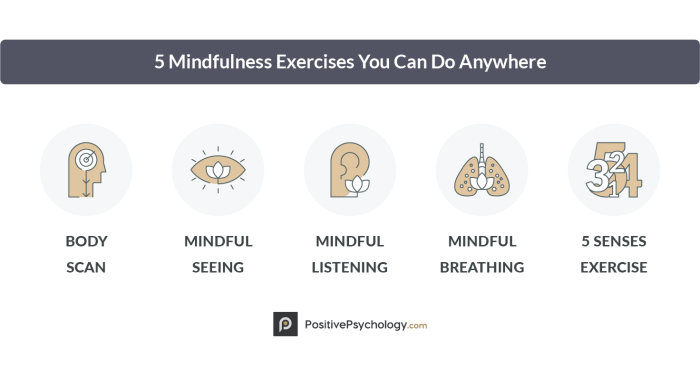Mindfulness Exercises are all about improving mental well-being through practice. Dive into a world of relaxation and self-awareness with popular exercises like mindful breathing, body scan meditation, mindful eating, and walking meditation.
Introduction to Mindfulness Exercises
Mindfulness exercises are practices that help individuals focus on the present moment, increase self-awareness, and reduce stress. They involve techniques such as meditation, deep breathing, and body scans to cultivate a state of mindfulness.
Popular Mindfulness Exercises
- Body Scan: Involves mentally scanning your body from head to toe, paying attention to any sensations without judgment.
- Breathing Exercises: Focuses on deep, intentional breathing to calm the mind and body.
- Mindful Walking: Concentrates on the act of walking with awareness of each step and breath.
Benefits of Practicing Mindfulness Exercises
- Stress Reduction: Mindfulness exercises can lower stress levels by promoting relaxation and reducing anxiety.
- Improved Focus: Regular practice can enhance concentration and cognitive function.
- Emotional Regulation: Helps individuals manage their emotions better and respond more effectively to challenging situations.
Breathing Techniques: Mindfulness Exercises

Breathing techniques are an essential component of mindfulness exercises, helping individuals to focus on the present moment and calm their minds. Different breathing exercises can be used to promote relaxation and reduce stress levels.
Deep Breathing vs. Box Breathing
- Deep Breathing: Involves taking slow, deep breaths through the nose, allowing the abdomen to expand fully. This technique helps increase oxygen flow, promoting relaxation and reducing anxiety.
- Box Breathing: Also known as square breathing, involves inhaling for a count of four, holding the breath for a count of four, exhaling for a count of four, and holding the breath again for a count of four. This technique helps regulate breathing patterns and calm the nervous system.
Mindful Breathing Exercise
To perform a mindful breathing exercise, follow these steps:
- Find a quiet and comfortable place to sit or lie down.
- Close your eyes and take a few deep breaths to relax your body.
- Focus on your breath as it flows in and out of your body.
- Notice the sensation of the breath entering and leaving your nostrils or the rise and fall of your chest.
- If your mind starts to wander, gently bring your focus back to your breath without judgment.
- Continue this practice for a few minutes, gradually increasing the duration as you become more comfortable with the exercise.
Body Scan Meditation
Body scan meditation is a mindfulness practice that involves focusing on different parts of the body, one at a time, to bring awareness to physical sensations, thoughts, and emotions. This practice helps individuals connect with their bodies and become more present in the moment.
Process of Body Scan Meditation
Body scan meditation typically begins with focusing on the toes and gradually moving up through the body to the head. As attention is directed to each body part, individuals are encouraged to notice any sensations, tension, or areas of discomfort without judgment. By bringing awareness to the body in this way, practitioners can release tension, reduce stress, and promote relaxation.
Effects on the Body
Body scan meditation can help individuals develop a greater sense of body awareness, improve their ability to relax, and enhance overall well-being. Regular practice of body scan meditation has been linked to reduced anxiety, improved sleep quality, and increased mindfulness in daily life. By tuning into the body’s signals and learning to release tension, individuals can cultivate a deeper sense of calm and inner peace.
Role in Relieving Stress and Promoting Relaxation
Body scan meditation is a powerful tool for stress relief and relaxation. By systematically scanning the body and paying attention to physical sensations, individuals can release built-up tension and stress. This practice helps to ground individuals in the present moment, allowing them to let go of worries about the past or future. Body scan meditation can be particularly beneficial for those dealing with anxiety, chronic pain, or insomnia, as it provides a structured way to unwind and reconnect with the body.
Mindful Eating

Mindful eating is the practice of paying full attention to the experience of eating and drinking, both inside and outside the body. It involves being present in the moment, savoring each bite, and recognizing the thoughts, feelings, and sensations that arise during meals. This practice is deeply rooted in mindfulness, as it encourages individuals to engage with their food in a conscious and intentional manner.
Tips for Practicing Mindful Eating
- Avoid distractions: Turn off the TV, put away your phone, and focus solely on your meal.
- Use all five senses: Notice the colors, smells, textures, and flavors of your food.
- Eat slowly: Take small bites, chew thoroughly, and pause between each mouthful.
- Express gratitude: Acknowledge the effort that went into preparing your meal and the nourishment it provides.
- Listen to your body: Pay attention to hunger and fullness cues, and stop eating when you are satisfied.
Mindful eating helps develop a healthier relationship with food, promotes better digestion, and can prevent overeating.
Benefits of Mindful Eating, Mindfulness Exercises
- Improved digestion and nutrient absorption
- Enhanced awareness of portion sizes and hunger cues
- Reduced stress and anxiety related to food
- Promotion of healthier food choices
- Weight management and prevention of emotional eating
Walking Meditation
Walking meditation is a mindfulness practice that involves focusing on the sensations of walking to cultivate awareness and presence in the moment. It offers a unique way to practice mindfulness while being active and can have numerous benefits for both the mind and body.
Benefits of Walking Meditation
- Improves focus and concentration
- Reduces stress and anxiety
- Increases overall sense of well-being
- Enhances mind-body connection
How to Perform Walking Meditation
To perform walking meditation mindfully, start by finding a quiet space where you can walk uninterrupted. Begin by standing still and taking a few deep breaths to center yourself. As you start walking, focus on the sensations in your feet as they make contact with the ground. Pay attention to each step, the movement of your legs, and the rhythm of your breath. If your mind starts to wander, gently bring your focus back to the present moment and continue walking mindfully.
Integration into Daily Routines
- Take a mindful walk during your lunch break
- Practice walking meditation while walking your dog
- Incorporate mindful walking into your daily commute
- Use walking meditation as a way to unwind after a long day
